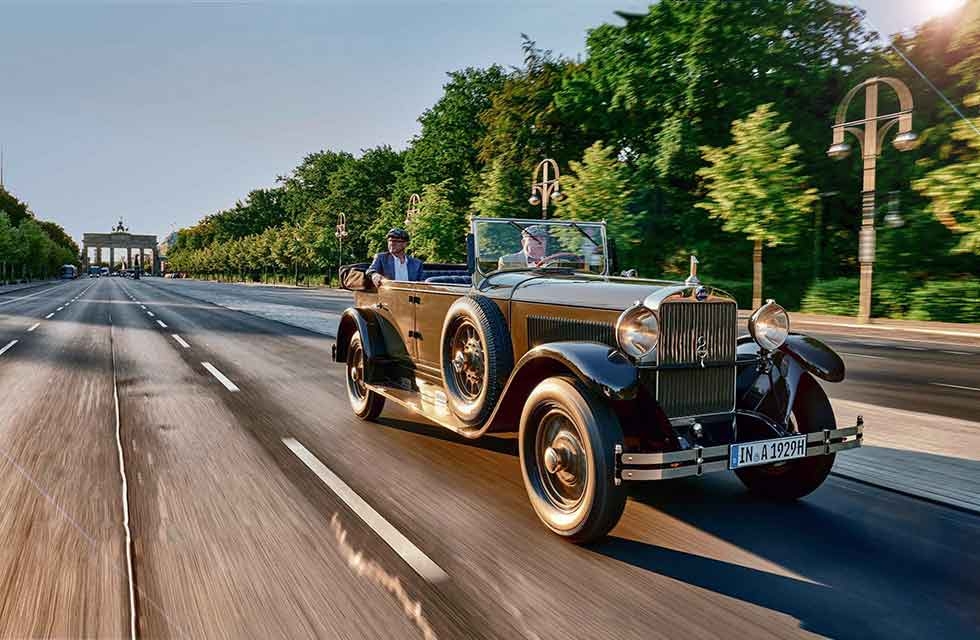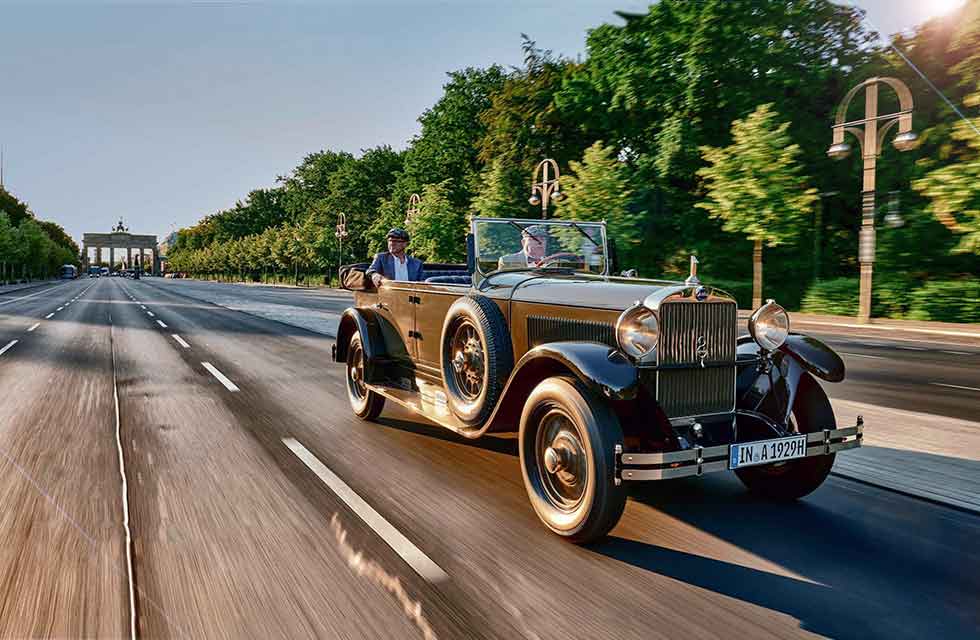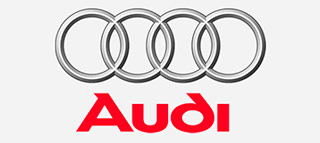
Eastern promise – Audi hasn’t always been a West German icon. Glen Waddington drives a unique survivor in Berlin. Photography Stefan Warter.
1929 Audi Type R Imperator in Berlin
A trip round Berlin in one of eastern Germany’s finest luxury cars
Here in the rural hinterland south of Berlin there are no Trabants in evidence and not a single Wartburg is to be seen. In fact, the only curious vehicle spotted so far is a 1957 IFA P2M jeep, and that belongs to Peter Spillner, proprietor of Fahrezengrestaurierung Rosenow, the subject of Day in the Life in Drive-My. No, here the roads are filled with the products of VW, Mercedes-Benz, Opel, BMW, just like the rest of Germany. And Audi too, of course – including the 1929 R Type Imperator restored by Herr Spillner for the Audi Museum Mobile in Ingolstadt, now being rolled out from his workshop. It’s a huge and imposing symbol of Audi’s late-20s might and technical expertise. Seems Vorsprung durch Technik goes way back. This Imperator is reckoned to be the sole survivor of 145 built. And those 145 were built at Zwickau, the town further south in eastern Germany where August Horch first set up a car-building company in his own name, before having to re-establish his business with the Latin translation of his surname (Audi means ‘hear’; the German equivalent is Horch).

Regular readers will know about the origins of Audi already, especially those who’ve read about the August Horch Museum in Drive-My. So they’ll also know that Zwickau became synonymous with the Trabant during the era of the German Democratic Republic, and that demand for smoky two-strokes fell away in favour of the VW Golf and its ilk as soon as the Berlin Wall fell.
‘I’M GETTING USED TO THIS: PAD ALONG SOME COBBLES, THEN SCATTER TRAFFIC LIKE A SHARK IN A SEA OF SQUID’
This 1929 car is significant in many respects, not least the fact that it’s one of very few indigenous cars to be seen in this region, and that it serves as a reminder of an era when Audi was not an icon of Bavaria. That, indeed, is a more modern construct that came about only when Volkswagen bought Auto Union from Mercedes-Benz in 1964, mainly for its production capacity. With it came a modest middle-class saloon with the need for an identity. Thus the Audi name was revived, and only in the past couple of decades has the four-ringed badge once more come to adorn limos with big-capacity eight-cylinder engines.
Which is what we have here, although it redefined vorsprung in the process, seeking a larger audience by being a less complex car than its Type M predecessor. Bear in mind the era: the Type R took over from the Type M in 1928, not long before the Wall Street Crash and the Great Depression. The luxury car market was already in decline, and Audi was already in the arms of Danish industrialist Jörgen Skafte Rasmussen, owner of Zschopauer Motorenwerke, which produced DKW motorcycles. By 1932, Audi had joined DKW, Wanderer and Horch as part of Auto Union, second from top (beneath Horch) in the brand hierarchy. The Type R, with its 4.9-litre straight-eight, marked the end of an era.
This is a big car, rebodied by Spillner in touring limousine style, but we’ll come back to that. For now, it’s time to get on board and get acquainted. There’s a simple painted dash panel with a small group of instruments dead centre, dominated by a clock and speedo and splayed around the ignition and light switches. Turn the key, press the starter, and that big straight-eight churns into life and settles to a rumble-and-chuff idle. Accelerator, brake and clutch pedals are where you’d expect, and there’s a long central gearlever to control the three-speed ’box, with first down to the left on a dogleg.
Moving off, everything feels as heavy as you might imagine: a weighty clutch, steering that’ll almost have you standing up when parking, and the brakes need a shove. A big shove, frankly, if you need to haul down the best part of three tonnes in a hurry. There was less traffic in the Imperator’s day. Thankfully, the country road away from Herr Spillner’s workshop in Glienick is pretty quiet, especially at this early hour, and we have a few miles during which to become accustomed before we tackle the city of Berlin.
First is dispatched quickly, used mainly for manouevring or steep hill starts, so soon it’s ger-dunk-dunk-dunk into second. That straight-eight is stoic, deep-voiced, somehow military in tone, not unlike the doppel-sechs engine of a Maybach from the same era, though the Audi’s engine is considerably smaller and four cylinders down. Roof-down, in the sun, along a straight and tree-lined lane, it’s easy to think you’ve travelled 90 years back in time. And that sensation continues as we approach Mittenwalde, the name of which translates as ‘middle of the forest’. It’s a picturesque village, and the car is attracting much attention, though people are surprised to find out that it’s actually an Audi.
The village is dominated by the 25m-high Pulverturm (‘powder tower’) and the Berliner Tor: the gate that serves as the entrance to Mittenwalde at its intersection with the road to Berlin. Both were part of the settlement’s medieval Stadtmauer (defence wall). Bearing in mind our location and our destination, we’ll be driving from one Brandenburg gate to another.
Back on the highway, with confidence building (not least because I’ve successfully negotiated several tight manoeuvres in the tiny streets of Mittenwalde), I pull away serenely, shifting gears with languid precision via that long lever, ultimately into top and settling into a long-legged cruise: 50mph keeps pace with the traffic, at which speed the ride is settled, sheer mass doing much to smother disturbances. The steering wheel needs hands on at all times, though for a car of this era it is surprisingly accurate, and it lightens up as soon as you have tarmac passing beneath the wheels.
Country roads give way to leafy boulevards as we enter Berlin, and I swap places with the Audi Museum Mobile’s archivist and restorations manager Ralf Hornung, who gives me some background while he refamiliarises himself with the controls. ‘The car was found in the 1990s,’ he tells me. ‘There was no body: just the chassis, engine, bulkhead and fenders. It had possibly been used by the fire brigade, as such cars had often served as a basis for conversion to service vehicles in early post-war times. For them, fuel consumption and tax were not an issue.
‘This was a few years before the Audi Museum Mobile opened. The Type R was safe, though we had no budget as yet for its restoration. But we wanted the Type M and the Type R ready for the opening. The Type M would be prepared as a cutaway exhibit, so that visitors could see its overhead-cam engine and its hydraulic brakes. It really was an advanced car. The Type R was Audi’s first with an eight-cylinder engine. That would be restored for driving.’ All of which is where Peter Spillner enters the tale, but we’ll be meeting him again later. For now, it’s time to soak up the sense of occasion, playing passenger in a car that represents an era in which Audi made a bid to lead the German luxury car market, the decade before Auto Union dominated Grand Prix racing. ‘We were more successful than Mercedes-Benz, you know,’ says Hornung.
Suddenly the Brandenburg Gate dominates the view. Parking isn’t allowed in this part of Berlin, so we take advantage of the glorious early morning sunshine and enjoy a guided tour of the city’s most famous sites. This 18th Century neo-classical monument is today a symbol of peace in Europe, though it suffered considerable damage during the final battles between German and Soviet troops in World War two. It was patched up during the Soviet era, but properly restored only as recently as 2002, at a cost of €6m.
Down Strasse des 17 Juni through the Tiergarten, from the rear seat of this imperious limousine I can see into leafy surroundings and marvel at the fact that much of the woodland was used for firewood in the Britishoccupied sector, while the land was turned over to the production of crops. That former use contrasts sharply with the Soviet monument to fallen soldiers of the Red Army, built in 1945 and which still survives. More recent monuments include a memorial to the homosexuals persecuted by the nazis.
Possibly even more poignant is the street we turn onto, renamed in 1995 to comemmorate the passing of Israeli President Yitzhak Rabin. He was known as a ‘fighter for peace’, and the comemmoration took place during an international conference on anti-Semitism, held in Berlin, and which remembered the city’s 50,000 Jews who died in the nazi concentration camps during World War two. Though the war began in 1939, much of the groundswell before it occurred very much in the era of the Audi Type R. Yitzhak Rabin Strasse provides a new perspective not only on Germany’s past but also its present, quite literally in the vista it affords of the Reichstag. Following the reunification of Germany in 1990, it was rebuilt and reopened as the seat of Germany’s government in 1999.
Feeling rather as though we’re impersonating dignitaries of another era, we pass by this impressive edifice, follow the block around and find ourselves in Pariser Platz, where we pull up outside the Hotel Adlon. The modern building was completed in 1997 in the style of the original, which dated back to 1907 and was destroyed in 1945, bar a small wing that remained in service until 1984.
Lorenz Adlon was a restaurateur who ran several coffee houses in Berlin. He convinced Kaiser Wilhelm II that Berlin needed a luxury hotel to rival those in Paris and London, and the Kaiser cleared the way for Adlon to have the historic Palais Redern demolished to make way for his venture. during the 1920s, the Adlon hosted celebrity guests such as Charlie Chaplin, Albert Einstein and Marlene Dietrich, and it remained a social hub throughout the nazi period. It is certain that this is not the first time an Audi Type R Imperator has caught the eye of its doormen.
Moving away from the historic centre of Berlin, we head across town to the Olympiastadion. It was completed in 1936, in time for that year’s Olympic Games, and Werner March’s architecture – in essence a modern vision of Rome’s Colosseum – is the perfect foil for the Imperator. It certainly attracts curious eyes here, the day after a concert held by Rammstein, one of Germany’s biggest rock bands.
The stadium housed the British military occupation forces from 1945, and only after reunification did Berliners have the chance to decide what its future would be. In the end, it was restored and reopened in 2004, and one of its early uses was as a venue during the 2006 FIFA World Cup.
I’m getting used to this: pad along some cobbles, then scatter traffic like a shark in a sea of squid, before spying another piece of eastern Germany’s great past that’s been brought back to life – rather like the Audi, in fact. Next stop, the Haus des Rundfunks, completed in 1929 – the same year as this Type R.
Its tiled façade conceals a triangular plan, designed by Hans Poelzig and built under the auspices of master planner Max H Berling. It’s one of the earliest buildings of its type, created to house Germany’s state broadcasting corporation, and it remains the home of the Berlin Radio Symphony Orchestra. The main broadcasting halls are built on foundations separate from the rest of the building, and the editorial offices feature movable walls, so that the number and size of rooms can vary according to need. It was a forward-thinking building that still serves its purpose eloquently, following restoration in 1987. Apparently it sounds as good as it looks.
With that, we’re nearing the end of our Berlin tour, heading back to Glienick via the Art Deco apartment buildings of Dahlem, known as ‘Berlin’s Oxford’, traditionally one of the most affluent parts of the city and, as home to the Freie Universität Berlin, a centre for academic research.
‘This is the only car for which I have built a body from nothing,’ says Peter Spillner. ‘I went to Ingolstadt to see what they had and what they wanted. Ralf Hornung had a drawing for the wooden frame. The rest we had to build. No roof, no windscreen. So I sat down with my coachbuilder and we worked out a plan.
‘The wood gives the shape, then you wrap the metal on the wood. All the work is in the little things. Even the doorhandles we cast ourselves, and the brackets for the windscreen. Ralf had a ’screen from another car; we borrowed that. Getting it right mostly involved looking at pictures of an original car.’
The whole project took 2½ years from start to finish. ‘That’s very quick for a project like this,’ says Spillner. ‘The engine and transmission were complete; we stripped them, fitted new bearings, pistons, and it all went back together. The wooden wheels we contracted out to a specialist. The interior was very similar to a horch’s, so we could compare it with one, though it isn’t like getting parts from a catalogue.’
The biggest difficulty was the hood. ‘We took measurements, applied them to a computer and used CAD to draw how it would operate. Then we made sections in wood, and applied trial and error until it worked. Then we talked to the upholsterer, talked about how the hood would fit the frame.’
The finished car is a triumph, even down to its tread strips, inscribed with ‘Rosenow-Wagenbau, Glienick’. There simply wasn’t another coachbuilder spillner could have attributed.
And with that ends a long and fascinating day. The Audi Type R Imperator is in so many ways a metaphor for the land from which it hails: eastern Germany. A region as advanced as any in Europe but which got overtaken by events, languished for decades, and then reasserted itself. As has the Audi, restored in the land of its forebears, and now a unique survivor.
Above Waddington plays passenger as Audi Tradition’s Ralf Hornung pilots the Type R Imperator into Strasse des 17 Juni, by the Brandenburg Gate. Clockwise from right Type R is in its element on the tree-lined country roads of eastern Germany, but equally at home amid the splendour of Berlin; genteel Dahlem district; Pariser Platz’s historic Hotel Adlon.
Left, below and bottom: Strasse des 17 Juni bisects Berlin’s Tiergarten; the Reichstag, seen from Yitzhak Rabin Strasse; elegant detailing contrasts with monumental 4.9-litre straight-eight. Top from left: Journey begins at Mittenwalde, and a city gate in Brandenburg; stylish Haus des Rundfunks houses Gorman state broadcaster, and dates back to the same year as this Type R; simple, functional mtenpr reveals itself outside equally functional Olympic stadium.
1929 Audi Type R Imperator
Engine 4872cc straight-eight, side-valve, Zenith carburettor
Max Power 99bhp @ 3300rpm
Max Torque 211lb ft @ 1500rpm
Transmission Three-speed manual, rear-wheel drive
Suspension Front and rear: solid axles, leaf springs
Brakes Drums
Weight 2300kg (chassis only)
Top speed 75mph






